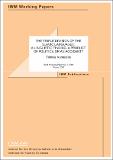The triple division of the Slavic languages : a linguistic finding, a product of politics, or an accident?
Abstract
The first and rather simple classificatory schemes of the Slavic languages appeared in the first half of the 19th century. The idea that languages develop from one another caught on when the heuristic diagram in the form of Stammbaum (genetic tree) was employed to portray this hypothesis in the second half of the 19th century. Quite unrealistically, the Stammbaum suggests that languages are discrete and self-contained entities, which rapidly branch out from their “parent languages,” as if they were actual “babies” born on a given day. On the other hand, it is well attested that the relatively “sharp” linguistic boundaries arise only between dialect continua, and even those can be bridged by creole continua. Within the dialect continuum language forms change gradually from village to village. The concept of “a language” requires that a segment of a dialect continuum (invariably connected to a power center, that is, a capital) be made into the basis of a written language, which is standardized by its widespread employment in administration, education and literature, and by the compilation of authoritative dictionaries and grammars as well. With the rise of standard languages, the illusion of discrete languages emerged, and became the normative concept of thinking about languages in general. In Central Europe this paradigm of thinking about the linguistic feed backed with the legitimizing force of ethnic nationalisms, in emulation of the German and Italian models. As a consequence, the specifically Central European model of ethnolinguistic nationalism came into being, characterized by the following equation, language = nation = state. This formula became the normative political standard in Central Europe. In accordance with it, ethnolinguistic nation-states were founded in the region. The linguistic Stammbaum perfectly suited the political needs of these new ethnolinguistic nation-states, because, “in the scientific manner,” it emphasized the “inherent separateness” of their languages and nations, which, in turn, legitimized the existence of the corresponding states as separate polities. Afterward, the self-fulfilling prophecy of this ethnolinguistic norm was actualized by official and social stigmatization of dialects, promotion of standard national languages via the mass media and the educational system, forced and economically-driven mass population movements, and expulsions of the speakers of languages other than the national ones. Inevitably, with the founding of the Central European nation-states the wealth of various classificatory schemes of the Slavic languages was “standardized” in line with the political reality to the still prevailing triple division of the Slavic languages, which apportions these languages between the Eastern, Southern, and Western “branches” of the Slavic “genetic tree.” This classification is presented as “scientific” and based on linguistic findings. But there are just two Slavic dialect continua, Northern and Southern, bisected by the West Germanic and East Romance dialect continua, and the remnant of the Finno-Ugric dialect continuum. Hence, it appears that the division between the Eastern Slavic languages, and the Western ones hinges rather on religious, alphabetic, and political cleavages, that is, extralinguistic ones. The normative force of the political equation language = nation = state that underlies the triple division of the Slavic languages is extremely strong to this day. German and Italian are shared as national languages by several nation-states and minority languages of stateless nations/ethnic groups (Sardinian, Frisian, Sorbian) are recognized in Italy and Germany, though sometimes grudgingly. On the contrary, not a single Slavic language is shared as a national language by nation-states. Thus, the breakup of Yugoslavia entailed the breakup of Serbo-Croatian into Bosnian, Croatian, Serbian, and, perhaps, Montenegrin. What is more, Poland withheld recognition to Kashubian as a language until the late 1990s, and still does not agree to recognize Silesian. Similarly, Bulgaria refuses to recognize Pomakian, Belarus Polesian, Ukraine Rusyn, and Croatia Bunjevcian as languages. It is so, because in the Central European paradigm of ethnolinguistic nationalism that would be tantamount to recognizing the speech communities of these languages as separate nations, ergo, their right to establish their own nation-states. The triple classificatory scheme of the Slavic languages, though of such recent and rather unscientific (that is, not purely linguistic) origin, has become a dogma of Slavic studies, accepted worldwide. This shows how intimate are the links between politics and academia; how the political influences research results; and how, by chance and coincidence, a heuristic device (for instance, the Stammbaum) suits some current political needs, and can be proclaimed the “true reflection” of reality, while the political is busy shaping this reality so it becomes identical with what is proclaimed. The reinforcing normative relationship between the model and reality being so strong and politically motivated, outside observers tend to mistake the model for reality. This explains the widespread, popular and unwavering acceptance of the triple classificatory scheme of the Slavic languages outside the Slavophone countries.
Citation
Kamusella , T D 2005 , The triple division of the Slavic languages : a linguistic finding, a product of politics, or an accident? IWM Working Papers Series , vol. 2005/1 , vol. 1 , IWM Working Papers Series edn , Institut für die Wissenschaften vom Menschen , Vienna .
Type
Book
Rights
© 2005 the Author. This work has been made available online with permission from the author.
Collections
Items in the St Andrews Research Repository are protected by copyright, with all rights reserved, unless otherwise indicated.

